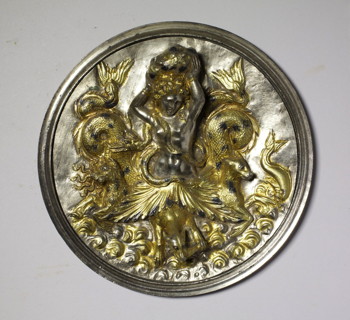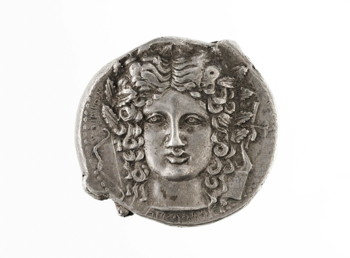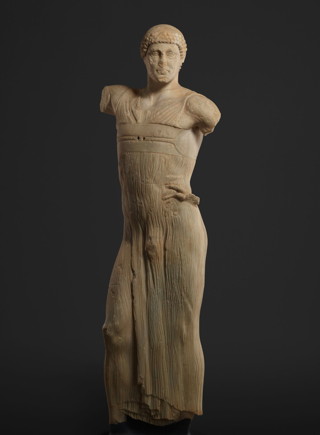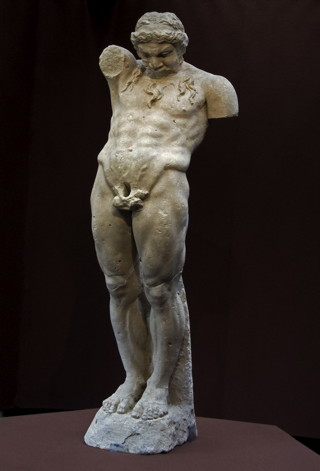The spectacular and newly conserved Mozia Charioteer statue from Sicily (pictured at left) forms the dramatic centerpiece of a new exhibition of antiquities at the Getty Villa. The thoughtfully curated exhibition showcases ancient Sicily as a major center of cultural innovation from the fifth to the third centuries B.C., when art, architecture, theater, poetry, philosophy, and science flourished and left an enduring stamp on mainland Greece and later on Rome.
The curators wanted to tell the unusual story of the colonization of Sicily in the late 700 B.C. by the Greeks. The focus of the exhibition is to demonstrate the era when Sicily culturally “came into its own.”
On view April 3–August 19, 2013, at the Getty Villa, Sicily: Art and Invention between Greece and Rome presents masterpieces of ancient art from the crossroads of the Mediterranean. On the island dear to Demeter and blessed with agricultural abundance, former Greek colonies emerged as powerful kingdoms during the fifth to third centuries B.C. Innovation in art, architecture, theater, poetry, philosophy, and science flourished, leaving an enduring stamp on mainland Greece and later on Rome. Some 150 objects bear witness to the athletic and military victories, religious rituals, opulent lifestyles, and intellectual attainments that shaped Classical culture at its peak.
An island at the crossroads of the Mediterranean, Sicily occupied a pivotal place in antiquity between Greece, North Africa, and the Italian peninsula.
“This is the first major exhibition to arise from the Getty’s 2010 Cultural Agreement with Sicily, presenting masterpieces that are among the most accomplished examples of ancient Greek art in the world,” said Timothy Potts, director of the J. Paul Getty Museum.
The exhibition features some 150 objects, a major portion on loan from institutions in Sicily, including stone and bronze sculptures, vase-paintings, votive terracotta statuettes and reliefs, carved ivory, gold and silver metalwork, jewelry, inscriptions, architectural revetments, and coins.
“These splendid objects bear witness to the athletic and military victories, religious rituals, opulent lifestyles, and intellectual attainments of the Sicilian Greeks, which shaped Greek culture at its peak,” explains Claire Lyons, acting senior curator of antiquities at the J. Paul Getty Museum and curator of the exhibition.
The Mozia Charioteer, widely considered one of the finest surviving examples of Greek sculpture, serves as the exhibition’s centerpiece. Recently on view at the British Museum in London during the 2012 Summer Olympics, the statue has since undergone conservation treatment at the Getty Villa. Part of the Getty’s cultural agreement with Sicily, this 18-month collaborative conservation project involved remounting the sculpture and the provision of a seismic isolation base, which will accompany the object when it is reinstalled at the Whitaker Museum on the island of Mozia.
The triumphant Mozia Charioteer, discovered in 1979 on the island of Mozia in western Sicily, is believed to represent a charioteer who competed at Olympia on behalf of one of the Sicilian rulers. The extraordinary style of the sculpture, especially notable in the sinuous pleating of the long linen that sheathes the figure’s athletic physique, is a tour-de-force of stone carving. Clearly a master of his craft, the sculptor was able to reveal the torso and limbs beneath the thin fabric. With its confident gaze and proud stance, this statue conveys the high level of originality and experimentation achieved by Greek sculptors working in Sicily. 
Important evidence of Sicilian artistic innovation is also apparent in the exquisite coins of the time. Beginning in the late fifth century B.C., a group of Sicilian Greek coin engravers, mainly based in Syracuse, added their signatures to the dies used to stamp coins. Known as the “Signing Masters,” these remarkable craftsmen created extraordinary works of art on a miniature scale. Departing from the traditional profile view, they devised novel ways of representing the human body in a lively three-quarter perspective or striking frontal pose.
This testimony of individual mastery of the medium is virtually exclusive to Sicilian Greek coins created around 400 B.C. Often abbreviated in tiny but legible script, the artists’ signatures are typically all but hidden in locks of hair or elements of jewelry.
Known as the “coin of coins,” the unique Aitna tetradrachm from the Royal Library of Belgium is one of the most precious ancient coins in the world. On view in the exhibition along with 50 other exceptionally crafted Sicilian Greek coins, the image on the tetradrachm depicts the head of Silenos on the obverse and on the reverse, Zeus enthroned with an eagle perched beside him, imagery that alludes to the cult of Zeus on Mt. Etna.
Sicily: Art and Invention between Greece and Rome will also examine how settlers from the Greek mainland brought their myths and religious practices to Sicily. To sanctify new colonies and maintain ties with mother cities, they built altars and temples to such gods as Apollo, the patron deity of colonists, as well as the deified hero Herakles. Included are terracotta heads of Apollo, Hades, and Persephone, created as cult or votive images of deities that played a central role in ancient Sicilian worship. The skillfully modeled clay, embellished with striking polychrome pigments, compares favorably with the most accomplished works in marble and bronze. An exceptional example of metalwork is a religious offering dish made of two and a half pounds of gold. Known as a phiale mesomphalos, the vessel is embossed from the center outward with bands of beechnuts, acorns, and bees above blossoms; the owner’s name—Damarchos, son of Achyris—is inscribed beneath the rim, together with its equivalent weight in gold coins.
The divine hero Herakles was also embraced by Greek settlers, who linked his deeds to their cities. Contrasting aspects of Herakles’ identity—peaceful healer, solitary herdsman, and violent aggressor—heightened the appeal of his cult among the men of rural Sicily, who tended flocks and worked as mercenary soldiers. Among the objects on view is a finely preserved bronze statuette of Herakles recovered from a river-bed in Contrada Cafeo (Modica), which suggests that a shrine to the hero was situated nearby.
Preeminent among the honored deities was Demeter, goddess of agriculture, and her daughter Persephone (or Kore). Sanctuaries of the goddesses dotted the island, but their cult was most enthusiastically embraced in central Sicily, where, according to myth, Kore descended to the Underworld as the bride of Hades. Depictions of these deities include a terracotta bust with a rare painted figural scene that may represent part of a ritual honoring or celebrating the goddesses, and a cult statuette discovered near an altar in Gela together with an offering jug of carbonized seeds of grain.
This exhibition has been co-organized by the J. Paul Getty Museum, the Cleveland Museum of Art, and the Assessorato dei Beni Culturali e dell’Identità Siciliana. It celebrates 2013 as the Year of Italian Culture in the United States, an initiative of the Italian Ministry of Foreign Affairs, realized under the leadership of the President of the Republic of Italy.









